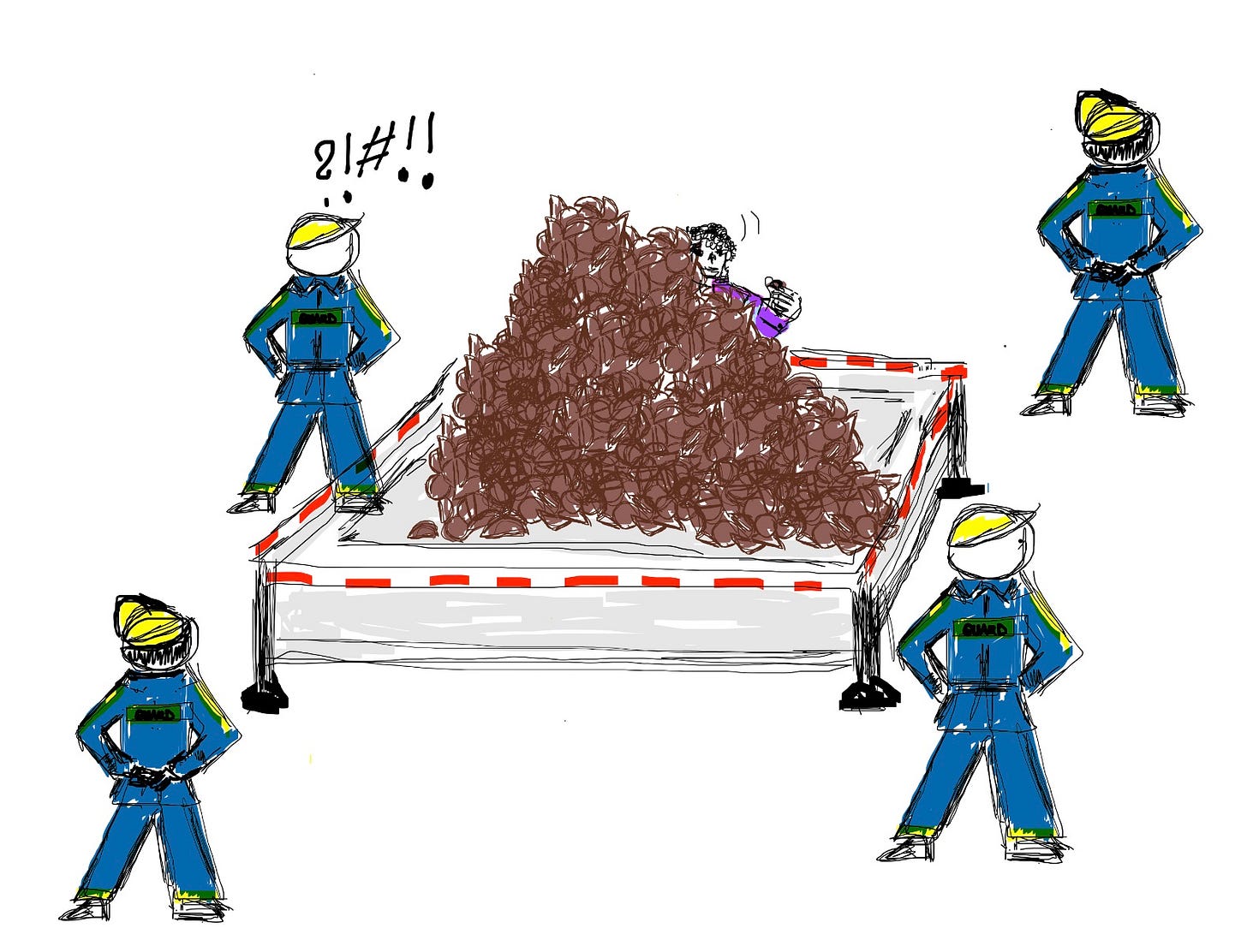It Takes Three to Tango
laziness is the desire for convenience, convenience is the product of efficiency, and efficiency often breeds laziness
Last broadcast’s Coherence Metric score was 2.245 ,placing it #19 overall! To understand what the Coherence Metric score is, check it out here :)
Efficiency, laziness and convenience: While at first these words may seem different and unrelated at first glance, I’d argue that these could be seen as three different flavours of the same thing, and all of these intertwine into each other just by changing a few factors, in a way not unlike an how artist mixes colours with different paints. But at the core, all three have a base desire to do or achieve something with as little effort and resources as possible. And as a result of all three, there is one word that comes out top…
Perspective
Let me set a scenario: you are a boss at a company and have just hired an employee. On Thursday you notice that the employee is staying extra hours after work, working hard. The next day you come in and notice that the same employee is now relaxed, legs on the desk, on his phone not working.
You confront him about his behaviour and ask him why he is being lazy. He responds that he managed to work efficiently yesterday, was on a roll, was going through most of what he had to do and it was convenient for him to stay a while longer yesterday to finish the week’s work, and now he is free to relax. Is he being efficient, lazy or both?
Convenience trumps all
I’d argue that even in a production process, convenience is more important than efficiency. Okay, I may be stretching the definition of convenience here, but lets give these two words a concrete definition:
Efficiency → Making the most out of limited resources (time, materials; space) to create an output
Convenience → Always having just the right amount of something when you need it
Don’t get me wrong, by these definitions, you need some level of efficiency to actually obtain this convenience: being able to procure something like this on demand requires a fast working, flexible supply - something that can only be achieved with efficiency: to a point.
Using a Cookie Lens
Let’s create a more advanced scenario: you make chocolate chip cookies and it’s a 3 step production process, going through 3 machines. The first machine (Machine A) makes the chocolate chips, and can make enough chocolate chips for 9 cookies an hour, in sets of 3 in 20 minute batches. The second machine (Machine B) makes the cookie dough, and can make enough cookie dough for 6 cookies an hour, but the machine can only make one portion at a time, so spends 10 minutes per cookie dough portion. And the third machine cooks the cookie into its final form and can make 40 per hour, being able to do 40 cookies in one go, but taking 60 minutes to do these 40.
To complicate things further, once a cookie is finished it can be packed and sold. If chocolates chips are made but are not immediately used they have to go into storage, where they have to be under tight security to stop workers from eating the chocolate chips. As for cookie dough, it doesn’t need the same level of security as the workers learned that eating raw cookie dough made them sick, so they doubled down on chocolate-chip stealing efforts instead.
So, what is the best way of organising the production of these 3 machines?
One idea could be to keep these machines running the entire time, to ensure that cookies are constantly being made. However, if machines are kept on regardless of other considerations, you are likely to get bottlenecks in the chain: After 5 hours, Machine A would have cranked out 54 cookies’ worth of chocolate chips, but Machine B would have only been able to use enough chocolate chips to make 28 cookies- (the first 20 minutes of those 5 hours it would have sat idle as it had no chocolate chips to make the second stage).
This means that by the end of the 5th hour, you would have a pile of around 26 cookie’s worth of chocolate chips lying around, which needs to be stored and guarded by the aforementioned security, which may be expensive, and in the long term, inefficient. So surely there’s a more efficient AND convenient method to do this?
Cooking up solutions
One way could be to keep Machine A running on and off for a few hours at a time, powering on only when chocolate chip reserves are running low, and when it is convenient to have . This could be seen as efficient as you are getting more chocolate chips per dollar spent on electricity or power to keep the machine running. However, then the money spent on labour is not as efficient, which may counteract any efficiency gained from the power. Additionally the time and cost of needing extra power, as well as the increased costs of maintenance and wear and tear, resulting from constantly restarting and stopping the machine, is also likely to negate any benefits.
So what if there was an option to have Machine A running at a lower intensity, so that it takes the machine 30 minutes, not 20, to make a batch of 3 cookie’s worth of chocolate chips. While this may make the machine more inefficient as its making fewer produce per hour, its electricity usage may be lower than originally assumed, which could mean that long term it is more viable. However, one would then have to contend with potentially lower efficiency of labour cost, as you would be paying workers the same wage to produce less. This is ‘ two steps forward, one step back’ personified.
The Core Issue
There has been a lot of focus so far on Machine A so far, but in reality our attention should be drawn to Machine B: it is the main bottleneck of the system, the area which is the limiting factor for us- the source of our inconvenience, something we want to avoid at all cost. We could invest into another machine B, so that the output on stage B doubles and is no longer the problem. However now, the rate at which Machine B works at outstrips Machine A’s, so we will run into inconvenience anyway when there will be chocolate chip shortages on the production line.
Sisyphean Task
This whole scenario may evoke imagery of a game of whack a mole, or those cartoons where they try to plug a leaking pipe: whacking a mole or plugging one leak often only leads to 2 more moles or leaks appearing. The key is what level of perspective to use, and what are your most important indicators: labour efficiency, machine efficiency or overhead efficiency? Logically you want highest overall macro- level of efficiency, but this ‘overall’ is the sum of all these other smaller indicators of efficiency, so which do you prioritise?
There are a thousand combinations to try find a solution: extra machines, slower working rates of machines, staggering when each stage is working while also training staff on all machines so fewer labour is needed. But each of these has their own drawbacks and considerations. The point is, a staggering amount of time and thought has been dedicated to making production processes like these, with the goal of maximizing convenience, and so that you can enjoy cookies made halfway across the globe for cheap.
Resting on Laurels
One other key consideration is that what is conveniently efficient now, may not be so in the future or with a large shift in the environment: one’s set up can be completely disrupted with the introduction of new technology, new management or processes, change in product design, anything.
But often people and corporations fall under the trap of some sort of efficiency inertia: Once a sufficient (or convenient) level of efficient is hit at a certain point in time, it is very difficult for them to adjust and adapt to the changing situation. As someone has a formula that worked for years, its very hard to admit that it doesn’t work anymore, and instead of changing one’s ways, often they have doubled down on their original work, which only accelerates their downfall. How often have you heard or seen the phrase ‘it’s how we’ve always done it”? What they often assume is the peak of the mountain in terms of success is only the peak of a wave, about to crash down in any second.
The Magic Word
To boil down what I’ve been trying to say: laziness is the desire for convenience, convenience is the product of efficiency, and efficiency often breeds laziness. So what is the thing that enables us to maximize convenience efficiently in order for most of us to be lazier? Logistics.
While factory’s and production centers may be seen as the beating heart of the global system, logistics are the arteries and veins that ensure the whole body runs smoothly. It is a timeless art, as no matter how developed, how advanced technology, goods and processes are, we will always be needing to move things from A to B when it is convenient, in an efficient manner, so that we can be lazy and not have to do every single thing ourselves.
Make sure to give this broadcast a coherence score!
That’s all from me for now, but stay tuned for future broadcasts,
This has been Kunga’s Written Radio,
Check out last week’s broadcast here →
The True Cost of Convenience
Hello everyone, today’s broadcast will be about perhaps the strongest drug of all: not nostalgia, not love, not cocaine, but convenience. It’s addictive nature affects almost all of us, and people will much quickly riot over losing some level of convenience over something that is actually much more important in the grand scheme of things. But nothing in…









Work smart not hard 🤷♀️